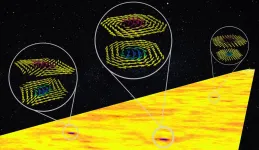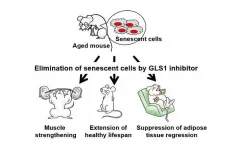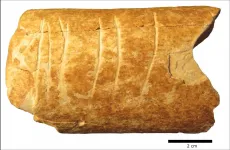Innovation from Vienna: Ultrasound in the treatment of brain diseases
New treatments are already on the brink of broad clinical application
2021-02-04
(Press-News.org) Ultrasound is not only used as an imaging technique but targeted pulses of ultrasound can be used as a highly accurate treatment for a range of brain diseases, for which there were previously only limited treatment options. Over the last few years, several revolutionary techniques of this kind have been developed, primarily in Toronto but also at MedUni Vienna. The Viennese technique improves brain functions by externally activating neurons that are still functional. Improvements can be expected in various neuropsychiatric brain diseases such as Alzheimer's, Parkinson's, stroke, Multiple Sclerosis, and neuralgia. A review jointly written by MedUni Vienna and the University of Toronto and published in the specialist journal "Advanced Science" shows that the new treatments are already on the brink of broad clinical application.
Over the last few years, new concepts for ultrasound brain therapy have been developed. Highly focused ultrasonic waves can now be used for non-invasive surgery, focal delivery of therapeutics or genes to selected areas of the brain and therapeutic modulation of neural networks in various brain diseases. According to Roland Beisteiner, who oversaw the development of the new method of transcranial pulsed stimulation with ultrasound (TPS) at the Department of Neurology of MedUni Vienna and Vienna General Hospital, the new ultrasound techniques are not just a "take-it-or-leave-it" choice but a genuine advantage for clinical practice. "The techniques developed in Vienna and Toronto represent innovative additional options we can use to supplement the existing established treatments. The patient data that has now been published show that the transcranial ultrasound innovations are safe and ready for broad clinical application." The huge extra advantage of the Viennese technique is that it is virtually free from any side-effects.
Viennese TPS: broad clinical roll-out in sight
The TPS neural stimulation technique developed by an international consortium led by Vienna was presented as the cover article in a top scientific journal at the beginning of 2020. Alzheimer's patients in this pilot study displayed sustained improvements over a period of three months. The broad clinical roll-out has already started but, according to Beisteiner, requires special expertise: "The new treatment is an ongoing scientific development and requires clinicians to have specific neurological and methodological expertise, as well as knowledge of brain function," explains Beisteiner. As well as diseases such as Alzheimer's, Parkinson's, stroke, Multiple Sclerosis, and neuralgia, which have previously also been investigated with older, less accurate brain stimulation techniques, there are probably completely new applications for TPS as well. TPS is the only technique that can also activate deep regions of the brain in a targeted and non-invasive way. Therefore, all diseases where it is possible to restore disrupted brain functions by activating still-functional neurons, are candidates for the new Viennese therapy. TPS is already licensed for the treatment of Alzheimer's (CE certification).
Ultrasound techniques from Toronto: different technique, different targets
The two other techniques developed at the University of Toronto under the clinical lead of study co-author Andres Lozano likewise use ultrasonic waves. Targeted, non-invasive ultrasound surgery is already licensed for essential tremor and tremor-dominant Parkinson's disease.
For the first time, it is now possible to treat brain malfunctions by targeted deactivation of overactive neurons without the need to open the skull, making this a technique that could be relevant in the future for many neurological movement disorders. The third innovative ultrasound technique, targeted drug, antibody or gene therapy, solves one of the main challenges in neurology, in that it facilitates non-invasive local opening of the blood-brain barrier. Although many highly effective therapeutics are essentially available, it is not always possible to deliver them to the necessary site in the brain. "By overcoming this barrier, it is now possible to deliver therapeutics and genes to the affected brain areas for the first time. This can potentially be used to treat all brain diseases where local drug therapy is effective, such as tumours and motor system diseases, for example," says Beisteiner.
Requests to participate in studies
The new ultrasound treatments are being offered in the context of studies and at various treatment centres. However, since these are highly complex techniques, they require extensive briefing of patients and proven neuroscientific expertise to carry out the treatment.
INFORMATION:
For further information: Prof. Dr. Roland Beisteiner: roland.beisteiner@meduniwien.ac.at, Information hotline Tuesday to Thursday 9:00-12:00 hrs: 0043-1-40400-34060.
ELSE PRESS RELEASES FROM THIS DATE:
2021-02-04
Researchers at NUI Galway have identified genomic signatures in women developing the most common type of breast cancer that can be associated with long-term survival. The NUI Galway team analysed the genomes of breast cancer patients to look for associations with survival rates using advanced statistical techniques.
Carried out by Lydia King during her studies in NUI Galway's MSc in Biomedical Genomics programme, the research has been published in the international journal PLOS ONE.
Early detection by national screening programmes and timely treatment for patients diagnosed with "luminal" types of breast cancer have resulted in excellent prognoses with survival rates of over 80% within five years of treatment. The challenge of long-term survival ...
2021-02-04
FOOD SCIENCE Sweden takes first, Denmark second and Norway lags at the bottom when it comes to how much organic food is served in canteens, kindergartens and other public sector workplaces across the three Nordic nations. This, according to the results of a new report by the University of Copenhagen. The report details plenty of potential for expanding the conversion to organic food service in the Danish public sector--a topic of discussion across the EU at the moment.
Plate with potatoes and beef
The governments of Denmark, Norway and Sweden are all keen on ramping up the amount of organic food ...
2021-02-04
The FinnBrain research of the University of Turku has demonstrated for the first time that the stress the father has experienced in his childhood is connected to the development of the white matter tracts in the child's brain. Whether this connection is transmitted through epigenetic inheritance needs further research.
Evidence from multiple new animal studies demonstrates that the changes in gene function caused by environment can be inherited between generations through gametes. In particular, nutrition and stress have been proven to cause these types of changes. However, these do not alter the nucleic acid sequence of ...
2021-02-04
Today's digital world generates vast amounts of data every second. Hence, there is a need for memory chips that can store more data in less space, as well as the ability to read and write that data faster while using less energy.
Researchers from the National University of Singapore (NUS), working with collaborators from the University of Oxford, Diamond Light Source (the United Kingdom's national synchrotron science facility) and University of Wisconsin Madison, have now developed an ultra-thin material with unique properties that could eventually achieve some of these goals. Their ...
2021-02-04
A study published in the journal Pediatrics expands validation evidence for a new screening tool that directly engages preschool-age children during clinic visits to assess their early literacy skills. The tool, which is the first of its kind, has the potential to identify reading difficulties as early as possible, target interventions and empower families to help their child at home, according to researchers at Cincinnati Children's Hospital Medical Center.
The Reading House (TRH) is an assessment for ages 3-5 based on a specially designed children's book, which was developed by John Hutton, MD, and his team at Cincinnati Children's. Screening takes five minutes and gauges performance levels ...
2021-02-04
An inexpensive, long-lasting and easy-to-administer vaccine against malaria could be a game-changer for millions of people living in countries where the mosquito-borne disease is endemic.
Lucie Jelinkova, a graduate student in the laboratory of Bryce Chackerian, PhD, professor in The University of New Mexico Department of Molecular Genetics & Microbiology, has identified a method that could make that dream into reality.
In research recently published in the journal NPJ Vaccines, Jelinkova and colleagues at Johns Hopkins and Flinders University in Australia report ...
2021-02-04
Tuberous sclerosis complex (TSC) afflicts as many as two million people around the world, affecting multiple organs, including lungs, brain, skin and kidneys. In about 80 percent of cases, it causes cysts and benign tumors to form in the kidney, eventually resulting in kidney failure.
It's known that the disease is triggered by genetic mutations, but how these mutations lead to the formation of kidney cysts has been poorly understood - until now.
Nephrologist Manoocher Soleimani, MD, a professor in The University of New Mexico Department of Internal Medicine, led a team that solved the puzzle and pointed the way toward potential ...
2021-02-04
Twitter has long provided a short, sharp take on the community's fears, anxieties and experiences. Now, data scientists have analysed 94 million tweets from the first months of the pandemic to track COVID-19's effect on mental health in NSW.
The research team used machine learning to develop a model able to capture data indicating depression, stress, anxiety and suicidal thoughts among users of the social media platform.
The aim was to tap into popular technology to help public health experts identify changes in community levels of depression over time.
The World Health Organisation highlighted early in 2020 that the pandemic would likely have a negative impact on mental health, with the disease affecting many facets of life including work, health and relationships.
Researchers from ...
2021-02-04
Senescent cells accumulate in organs during aging, promote tissue dysfunction, and cause numerous aging-related diseases like cancer. The cells arise through a process called "cellular senescence," a permanent cell cycle arrest resulting from multiple stresses.
A collaborative research group led by Professor Makoto Nakanishi of the Institute of Medical Science, The University of Tokyo (IMSUT), and co-researchers has identified an inhibitor of the glutamate metabolic enzyme GLS1(*1) so that its administration selectively eliminates senescent cells in vivo. They confirmed that the GLS1 inhibitor eliminated senescent cells from various organs and tissues in aged mice, ameliorating age-associated tissue dysfunction and the symptoms of obese diabetes, arteriosclerosis, and ...
2021-02-04
While scientists and historians have long surmised that etchings on stones and bones have been used as a form of symbolism dating back as early as the Middle Paleolithic period (250,000-45,000 BCE), findings to support that theory are extremely rare.
A recent discovery by archeologists from the Hebrew University and the University of Haifa alongside a team from the Le Centre National de la Recherche Scientifique in France have uncovered evidence of what may be the earliest-known use of symbols. The symbols were found on a bone fragment in the Ramle region in central ...
LAST 30 PRESS RELEASES:
[Press-News.org] Innovation from Vienna: Ultrasound in the treatment of brain diseases
New treatments are already on the brink of broad clinical application




